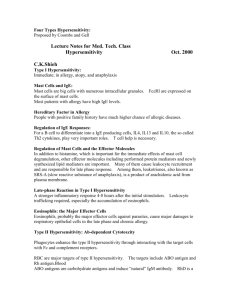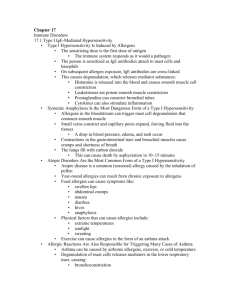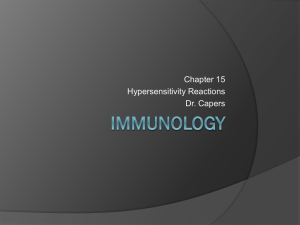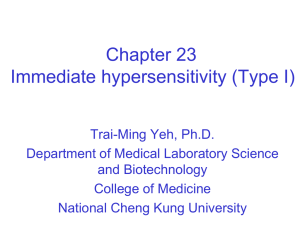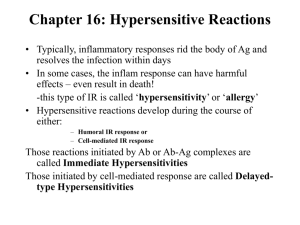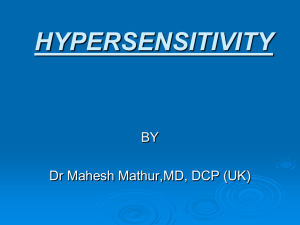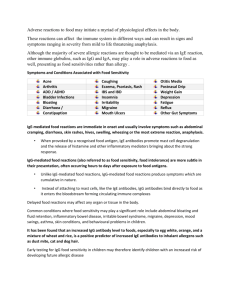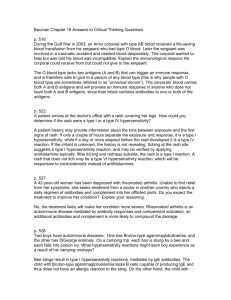Allergy and Hypersensitivity
advertisement
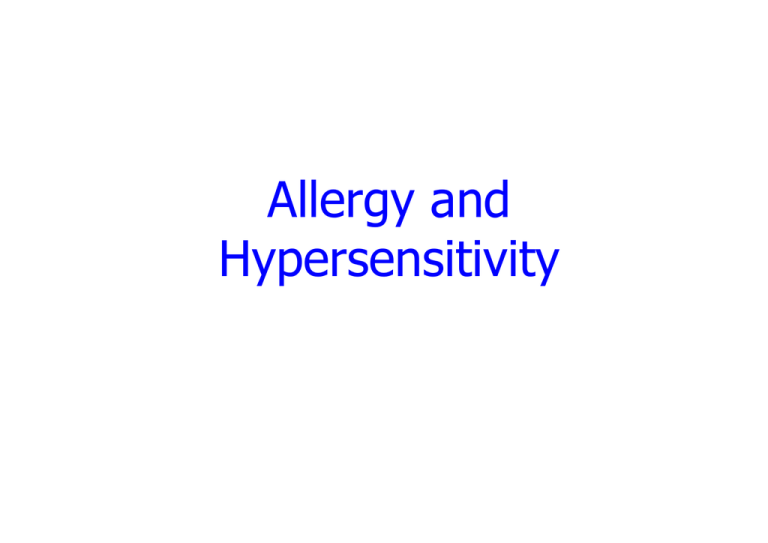
Allergy and Hypersensitivity Allergy • A disorder of the immune system often also referred to as atopy • Strictly, allergy is one of four forms of hypersensitivity and is called type I (or immediate) hypersensitivity. • Allergic reactions occur to normally harmless environmental substances known as allergens • Reactions are acquired, predictable, and rapid • Include eczema, hives, hay fever, asthma attacks, food allergy, and reactions to drugs and the venom of stinging insect such as wasp and bees Hives (Skin rash) Hay Fever (Allergic Rhinitis) • The primary symptom is nasal dripping and nasal congestion. • Caused by chronic or acute inflamation of the mucous membrane of the nose due to viruses, bacteria or airborne allergens. • Rhinitis also adversely affect throat and eyes. • Rhinitis is caused by an increase in histamine • About 15% of US polpulation suffer from this allergy Hypersensitivity Reactions • Excessive, undesirable (damaging, discomfort-producing and sometimes fatal) reactions produced by the normal immune system. • Require a pre-sensitized (immune) state of the host • Gell-Coombs Classified the reactions into four types based on the mechanisms involved and time taken for the reaction • Type I, type II, type III and type IV • Produce tissue injury Hypersensitivity Types & Immune Reactant • 3 involve antibody• Type I (immediate): mediated by IgE (Mast Cells) • Type II: mediated by IgG or IgM • Type III (immune complex disease): IgG & complement • One involves antigen specific cells. • Type IV: Delayed type hypersensitivity, cellmediated immune memory response. Type I Hypersensitivity • Known as immediate or anaphylactic hypersensitivity • Sudden, widespread, potentially severe and life-threatening allergic reactions. • Involve skin, eyes, nasopharynx bronchopulmonary tissues and gastrointestinal tract • The reaction usually takes 15 - 30 minutes from the time of exposure to the antigen • Begin with a feeling of uneasiness, followed by tingling sensations and dizziness. • Rapidly develop severe symptoms, including generalized itching and hives, wheezing and difficulty breathing, fainting, or a combination of these and other allergy symptoms. Anaphylactic reactions (anaphylaxis) • Most commonly caused by • Drugs (such as penicillin) • Insect stings • Certain foods (particularly eggs, seafood, and nuts) • Allergy injections (allergen immunotherapy) • Latex Type I Hypersensitivity Reactions Systemic anaphylaxis: an acute multi-system severe type I hypersensitivity reaction that can cause shock, or even death Injection IngestionÆblood stream Inhaled/Airborne Allergic runny nose: Irritation and inflammation of some internal areas of the nose Asthma - lower ariways Insect bite Wheal and flare allergy: skin reaction which occurs in response to exposure to an allergen. This distinctive reaction is often used in testing for allergies to determine which allergens trigger a reaction in a patient. Hives-ingestionÆskin A rash that is caused by an adverse reaction to certain substances. In most cases, allergy hives can be traced to certain foods or medication Type I Hypersensitivity • Mediated by IgE. • The primary cellular component is the mast cell or basophil. • The reaction is amplified and/or modified by platelets, neutrophils and eosinophils. • The reaction site is mainly mast cells and eosinophils. Mechanism of Reaction • Involves preferential production of IgE, in response to certain antigens (allergens). • IgE has high affinity for its receptor on mast cells and basophils. • A subsequent exposure to the same allergen cross links the cell-bound IgE and triggers the release of various pharmacologically active substances • Produce IgE from B-cell • Cross-linking of IgE Fc-receptor to mast cells increases Calcium influx in Mast cells and trigger degranulation of mast cells Induction and effector mechanisms in type 1 hypersensitivity T-helper cells • Antigen presentation stimulates T cells to become either "cytotoxic" CD8+ cells or "helper" CD4+ cells. TCR: T-cell receptor • MHC proteins are only found on the surface of specialised antigenpresenting cells (APCs). Type I hypersensitivity Response to innocuous antigen (allergen) IgE bound to mast cells is cross-linked Mast cell degranulation localized or systemic Effects On blood vessels ↑ blood flow & permeability ↑fluid, cells protein in tissues ↑ flow to lymph node Effects On airway ↓ diameter, ↑ mucus congestion, blockage On GI ↑fluid secretion, ↑peristalsis Expulsion-diarrhea or vomiting Atopy Tendency to mount an exaggerated IgE response In the developed worldÆAllergies and asthma are on the increase. WHY? Environmental Factors? Genetics Environment-Are we too clean? Industrial pollution Early exposure to infectious disease Dust mite feces Occupational hazards? Diagnostic tests for immediate hypersensitivity • Skin (prick and intradermal) tests • Measurement of total IgE and specific IgE antibodies against the suspected allergens. • Total IgE and specific IgE antibodies are measured by a enzyme immunoassay (ELISA). • Increased IgE levels are indicative of an atopic condition • A genetic predisposition for atopic diseases Skin-Prick Test close-up view of intradermal skin test with multiple positive allergen responses Treatments • Antihistamines which block histamine receptors. • Chromolyn sodium inhibits mast cell degranulation by inhibiting Ca++ influx. • Leukotriene receptor blockers or inhibitors of the cyclooxygenase pathway • Bronchodilators (inhalants) for bronchoconstriction • Inhinbitors for cAMP-phosphodiesterase • Use of IgG antibodies against the Fc portions of IgE that binds to mast cells - block mast cell sensitization. • Hyposensitization (immunotherapy or desensitization) to insect venoms and pollens Type II hypersensitivity • Known as cytotoxic hypersensitivity • The antigens are normally endogenous, although exogenous chemicals can also lead to type II hypersensitivity. • Autoimmune thrombocytopenia, autoimmune hemolytic anemia, Rh disease of the newborn • The lesion contains antibody, complement and neutrophils • The reaction time is minutes to hours. • Primarily mediated by antibodies of the IgM or IgG classes and complement • Antibody (IgG) mediates cell death Type II hypersensitivity • The antibodies produced by the immune response bind to antigens on the patient's own cell surfaces • These cells are recognized by macrophages, which act as antigen presenting cells • This causes a B cell response where antibodies are produced against the foreign antigen. • penicillin bind to red blood cells causing them to be recognised as different, • B cell proliferate and antibodies to the drug are produced. • IgG and IgM antibodies bind to these antigens to form complexes that activate the classical pathway of complement activation to eliminate cells presenting foreign antigens. • Mediators of acute inflammation are generated at the site and membrane attack complexes cause cell lysis and death. IgG and clearance of Immune complexes Antibody-Dependent Cell-Mediated Cytotoxicity (ADCC) • Another form of type II hypersensitivity • Cells exhibiting the foreign antigen are tagged with antibodies (IgG or IgM). • The tagged cells are then recognised by natural killer (NK) cells and macrophages (recognised via IgG bound (via the Fc region) to the effector cell surface receptor (FcγRIII)), which in turn kill these tagged cells Type II cytotoxicity mechanism IgG made to foreign bacteria Type II hypersensitivity • Diagnostic tests include • Detection of circulating antibody against the tissues involved • The presence of antibody and complement in the lesion (biopsy) by immunofluorescence. • Treatment involves anti-inflammatory and immunosuppressive agents Type III hypersensitivity • Immune complex hypersensitivity • The reaction may be general or may involve individual organs including skin, kidneys, lungs, blood vessels, joints (e.g., rheumatoid arthritis) or other organs. • This reaction may be the pathogenic mechanism of diseases caused by many microorganisms • The reaction may take 3 - 10 hours after exposure to the antigen Type III hypersensitivity • Mediated by soluble immune complexes - mostly of the IgG class and sometimes IgM • Both exogenous (chronic bacterial, viral or parasitic infections) and endogenous (non-organ specific autoimmunity) antigens can cause it. • The antigen is soluble and not attached to the organ involved. • Primary components are soluble immune complexes and complement (C3a, 4a and 5a). • The damage is caused by platelets and neutrophils Immune complex hypersensitivity Type III hypersensitivity • Small immune complexes formed - antigen excess, not cleared efficiently • Deposit in vascular wall (vasculitis) • Deposit in kidney (glomerulonephritis) • Deposit in joints (arthritis) • Hall mark is inflammatory response Type III hypersensitivity • The affinity of antibody and size of immune complexes are important in production of disease and determining the tissue involved. • Diagnosis involves • Tissue biopsies for deposits of Ig and complement by immunofluorescence. • The presence of immune complexes in serum and depletion in the level of complement • Polyethylene glycol-mediated turbidity to detect immune complexes. • Treatment includes anti-inflammatory agents. Systemic Type III response • Serum sickness from passive immunitysystemic • Self-limiting as clears antigen Type IV Hypersensitivity • Known as cell mediated or delayed type hypersensitivity • The reaction takes two to three days to develop. • The classical example is tuberculin reaction • Involved in the pathogenesis of many autoimmune and infectious diseases • tuberculosis, leprosy, blastomycosis (fungal infection), toxoplasmosis (a parasitic disease). • granulomas due to infections and foreign antigens. • contact dermatitis (poison ivy, chemicals, heavy metals, etc.) • Can be classified into three categories depending on the time of onset and clinical and histological presentation Classifications of Type IV Hypersensitivity Type Contact Reaction clinical time appearance 48-72 hr Tuberculin 48-72 hr eczema local induration Granuloma 21-28 days Hardening histilogy Antigen and site lympocytes followed by Epidermal (organic macrophage edema of chemicals, poisons ivy, epidermis heavy metals etc. lympocytes, monocytes, intradermal (tuberculin macrophages macrophages, lepromin, etc persistent antigen or epitheoid and giant foreign body presence cells, fibrosis (tuberculosis, leprosy, etc.) Mechanisms of damage in delayed hypersensitivity • TH1 release cytokines to activate vascular endothelium • Cytokines activate macrophages and cause release of cytokines and chemokines • Activated macrophages to produce chemotactic factor, interleukin-2, interferon-gamma (IFN-γ), Tumor necrosis factor (TNF), cytotoxin etc. • Transform macrophages into multinucleated giant multinucleated cell, which eventually becomes necrotic and dies Release of cytokines to activate vascular endothelium Effector mechanisms Mantoux intradermal tuberculin skin test for tuberculosis Diagnostics and Treatments • Diagnostic tests in vivo include delayed cutaneous reaction (e.g. Montoux test) and patch test (for contact dermatitis). • In vitro tests for delayed hypersensitivity include mitogenic response, lympho-cytotoxicity and IL-2 production. • Corticosteroids and other immunosuppressive agents are used in treatment Food Allergy Food Allergies and Other Food Sensitivities • Individualistic adverse reactions to foods – Affect only a few people in the population “One man’s food is another man’s poison” – Lucretius Adverse Food Reactions • IgE and non-IgE-mediated primary immunological sensitivities • Non-immunological food intolerances • Secondary sensitivities • These are considered collectively as food allergies • True food allergies represents only a fraction of the individualistic adverse reactions to foods True Food Allergies • Abnormal (heightened) responses of the immune system to components of certain foods • The components are typically naturally occurring proteins in the foods True food allergies • Immediate hypersensitivity reactions – Symptoms begin to develop within minutes to an hour after ingestion of the offending food – Involve abnormal responses of the humoral immune system – Production of allergen-specific immunoglobulin E (IgE) • Delayed hypersensitivity reactions – Symptoms begin to appear after 24 hr or longer – Involve abnormal responses of the cellular immune system – Produce sensitized T-cells Allergy-like Intoxications • Resemble true food allergies • Elevated levels of histamine can cause it – Histamine is from foods not released from intracellular locations, but resemble true food allergies – Frequently associated with consumption of spoiled scombroid fishes – All consumers are susceptible to histamine poisoning Food Intolerance • Non-allergic food hypersensitivity is the medical name for food intolerance • Caused by various organic chemicals occurring naturally in a wide variety of foods, food additives, preservatives, colourings and flavourings • Three categories • Anaphylactic reactions • Metabolic food disorders • Idiocyncratic reactions (the tendency to react atypically or with unusual violence to a food, drug, or cosmetic or any characteristic that is peculiar to an individual) Anaphylactoid Reactions • Caused by substances that bring about the release of the same mediators from mast cells without involvement of IgE – Presumed to destabilize the mast cell membranes allowing for the spontaneous release of histamines and other mediators (e.g., strawberry sensitivity) Metabolic food disorders • Due to a defect in the metabolism of the food or food component • Inherited defects in the ability to metabolize some component of food • From a genetically determined, enhanced sensitivity to some foodborne chemical that occurs through an altered metabolic pattern • Lactose intolerance: diminished β-galactosidase activity in the mucosal membrane of the small intestine – Undigested lactose pass into colon where colon bacteria metabolize the lactose to CO2, H2, H2O – Abdominal cramping and frothy diarrhea Favism Celiac Disease • Celiac spruce or gluten sensitive enteropathy • A mal-absorption syndrome occurring in sensitive individual upon the consumption of wheat, rye, barley, triticale etc • The epithelial cells in the small intestine are damaged by an inflammatory process • Absorption of nutrients through the epithelium is compromised • The loss of absorptive function and inflammation results in a severe malabsorption syndrome • Diarrhea, bloating, weight loss, muscle cramp, anemia, bone pain, and chronic fatigue • Prevalence - Occurred in about 1 of 3000 individuals in the U.S. • Treatment - avoidance diet or gluten-free diet Idiocyncratic reactions • Adverse reactions to foods or food components that occur through unknown mechanisms • Sulfite-induced asthma Secondary Food Sensitivities • Adverse reactions to foods or food components that occur with or after the effects of other conditions. • Secondary food sensitivities of lactose intolerance - gastrointestinal disorders • Secondary drug-induced sensitivities increased sensitivity to tyramine, a tyrosine derivative, that acts as a catecholamine, epinephrine (adrenaline) releasing agent IgE-Mediated Food Allergies • Called Immediate hypersensitivities • Type I allergy • Food anaphylaxis • Refer to “allergic reactions to foreign protein molecules” IgE Antibodies • One of 5 antibodies in the body (IgA, IgD, IgE, IgG, IgM) • Involved in fighting off parasitic infections • All humans have low levels of IgE antibodies • Individuals predisposed to the development of allergy produce IgE antibodies that are specific for and recognize certain environmental antigens • Allergens: pollens, mold spores, nee venoms, dust mites, food proteins Mechanism of IgE-mediated allergic reaction • Allergen stimulates production of allergen-specific IgE antibodies • IgE antibodies attach to receptors on mast cells and basophiles and sensitize them • Upon subsequent exposure to the allergic substances, the allergen cross-links two antibodies on the surface of mast cell or basophile membrane • Stimulate the release of histamine and other chemical mediators of the allergic response Pathogenesis of IgE-mediated allergic reaction Relationships between the various types of food sensitivities Symptoms of IgE-Mediated Food Allergies • Gastrointestinal symptoms – Nausea – Vomiting – Diarrhea – Abdominal pain – Colic • Cutaneous symptoms – Urticaria: skin inflamation – Eczema or atopic dermatitis – Angioedema: rapid swelling of skin, mucosa, and submucosal tissues – Pruritis: itch • Respiratory symptoms – Rhinitis: irritation and inflamation of the nose – Asthma • Other symptoms – Laryngeal edema – Anaphylactic shock – Hypotension Diagnosis • Self-diagnosis and parental diagnosis • Double blind test • Skin-prick test • Radioallergosorbent test (RASTs) • A blood test used to determine to what substances a person is allergic • Radiolabeled anti-human IgE antibody • Improved sensitivity, reproducibility Food Allergens • Almost always naturally occur • Only few proteins elicit allergenic reactions • Some foods such as milk, egg, peanut contain multiple allergenic proteins • Beef, pork, chicken and turkey meat are rarely allergenic • Allergenic proteins are resistant to digestion and stable to heat processing Prevalence • The overall prevalence estimate for IgEmediated food allergies has been between 2 and 2.5 % of the total population • Among infants younger than 3 year, the prevalence of food allergies appears to be in the range of 5 % to 8 %. Most Common (“The Big Eight”) Causes of Food Allergy Worldwide • Cereals containing gluten (wheat, rye, barley, oats, spelt or their hybridized strains and products) • Crustacea and products • Eggs and egg products • Fish and fish products • Peanuts and products • Milk and milk products • Tree nuts and nut products • Soybeans and products Development of IgE-Mediated Food Allergies • Genetics play an important role in the development of IgE-mediated allergies of all types, including food allergies. • Infants do not appear to develop allergies in utero, but can be sensitized during the first few days of life. Prevention of IgE-mediated Food Allergies • Development of food allergies can be delayed but not prevented • Avoidance of allergenic foods is the best strategies • Hydrolysis of proteins can increase oral tolerance • Some allergens can be destroyed by heat processing • Fermentation Cross-Reactions between Related Allergenic Foods • Allergic consumers sometimes experience crossreactions between closely related foods. • A few peanut-allergic individuals are also allergic to soybeans. Cross-Reactions between Food and Environmental Allergens • Cross-reactions are frequently observed between pollens and certain foods, especially fruits and vegetables. • Examples – birch pollen and apples, ragweed pollen and melons, mugwort pollen and celery • Latex allergies and bananas, kiwis, avocados and chestnuts Effect of Food Processing on Allergens • Heat-processed forms of commonly allergenic foods often retain their allergenicity because allergenic proteins are stable to heat processing. • Exception - pollen related allergens • Other processing techniques have not been so well investigated for their effects on the allergenicity of the resulting products. • Removed processing of allergenic proteins – Ex) highly refined peanut and soybean oil • Other ingredients may be derived from allergenic sources. - Ex.) Flavoring formulations, starch, lecithin and gelatin. Treatment to Allergic Reactions • Anti-histamine drugs • Epinephrine Allergenicity of Foods Produced through Agricultural Biotechnology • Novel protein production – Genetic modifications – Gene transfer • The potential of the novel proteins expressed in the new varieties produced through agricultural biotechnology is rather low • However, the potential allergenicities for the novel proteins in the new varieties produced through agricultural biotechnology should be assessed! • Agricultural biotechnology can also be used to decrease the inherent allergenicity of foods Assessment of the Allergenic Potential of Foods Derived From Biotechnology Implications for Food Manufacturing • Manufacturers are required to list all the ingredients of a food with two exceptions – Spices, flavoring agents, and colorings may be declared collectively without naming each specific substances – Incidental additives such as processing aids, present in insignificant levels and have no technical or functional effects in the finished foods • Manufacturers are required to follow GMPs Future Trends • A Food Allergy Issues Association and other interest organizations are discussing labeling guidelines – Identifying the major food allergens – Using terms commonly understood by consumers – Disclosing the presence of major food allergens when they are an intentional part of the food, regardless of source – Establishing guidelines for conditions when the use of supplemental statements is appropriate
